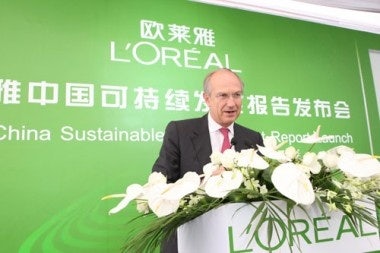China To Jump From Fifth Place In 2009 To Third, Trailing U.S. And France#

L’Oreal has bounced back from the global economic crisis in a big way, recently announcing double-digit Q2 growth powered mainly by developing markets like China and India. Among the BRICs, however, China looms large. Last week, Lan Zhenzhen, the vice-president of L'Oreal China, announced in Shanghai that the company expects China to leap two spots to become L'Oreal's third-largest market -- trailing only the U.S. and France -- within the year. From the Global Times:
"China has occupied five percent of the Group's market as of the end of last year, and the sales figures in the first half of this year have shown that China has moved even higher," said Lan, without elaborating on the exact figures.
The company witnessed a growth of 17.7 percent to 8.18 billion yuan ($1.21 billion) sales in China last year, a double-digit gain for the ninth consecutive year. L'Oreal has an 11.7 percent market share in China.
Currently, 17 of the group's 26 international brands have entered China. Francis Quinn, director of sustainable development for L'Oreal, said the company will "introduce little by little" other international brands to China as the market develops.
"I am not surprised at the growth figures," Xiao Mingchao, deputy general manager of Sinomonitor International, told the Global Times Thursday, explaining the company has developed in step with the growth of the Chinese economy in the past 13 years in China.
Also last week, a number of L'Oreal's top executives were in China for the grand opening of the L'Oreal China Research & Innovation Center and the release of the results of the 2009 L'Oreal China Sustainability Report. (L'Oreal's first country-specific report on sustainable development in China.) From Sina's coverage of the event:
L'Oreal’s dependence on the environment and consumption of resources have been significantly reduced, despite a very rapid growth in sales for the company in China over the past nine consecutive years. Statistics from L'Oreal China showed that in 2009, for each finished product, water consumption has decreased by 36%, and energy consumption was reduced by 5.26%, compared to the figures for 2007.
Its waste recycling and utilization rate has reached 99%, and furthermore, L'Oreal China employees have spent a total of around 14,475 hours participating in environmental, health and safety training. In the process of ensuring its own development, L'Oreal has not forgotten its employees and social responsibilities- the company's Chinese employees have received on average of 41 hours of training per person;and the company shared 16.9 million yuan of profits with them also. The company's external public welfare donations amounted to 7.69 million yuan, up by more than 14% compared to 2008.
...
The newly completed Shanghai Pudong R&I Center is a major achievement in sustainable development practice in China and also an incarnation of implementing the corporate social responsibility. The L'Oréal Pudong R&I Centre recently achieved the LEED (the U.S. Pioneer Award for Energy and Environmental Design) Gold Certification. (LEED is considered the best and most influential assessment criteria in the world among the environmental assessment of various types of construction, green building assessment and building sustainability assessment standards), issued by the U.S. Green Building Council.
During its design and construction, full consideration was given to the project's energy-saving and environmental protection efforts in order to minimize the impact on the natural environment; wherein, 22% of building materials are recyclable materials with 100% FSC certified wood, combined with the use of more environmentally friendly energy-saving technology, saving 24% of energy and 40% of water, compared with traditional building practices.